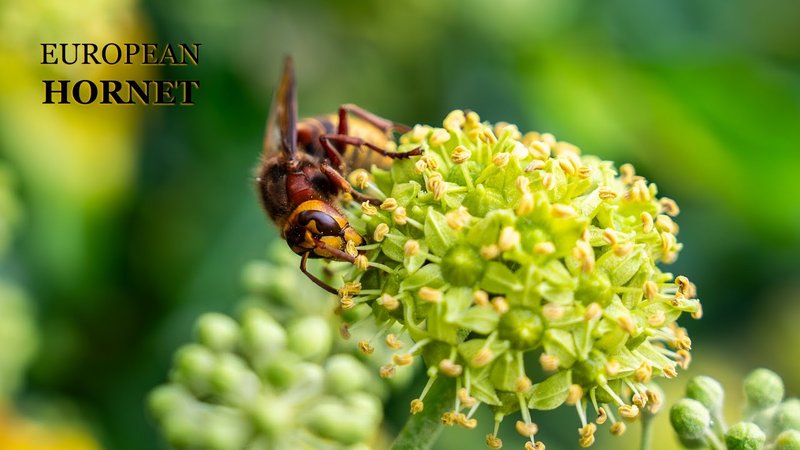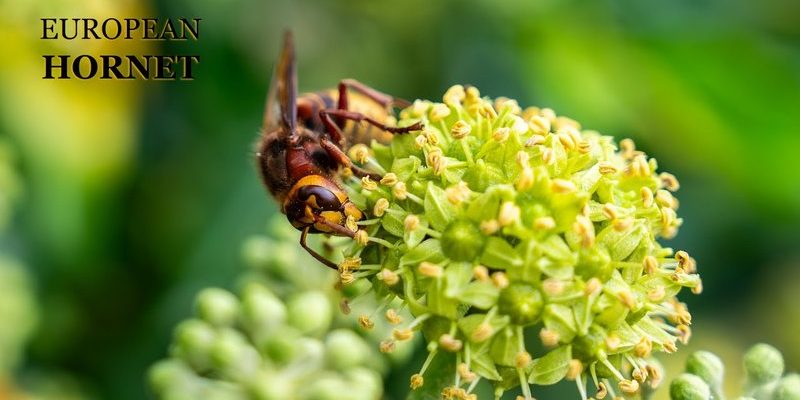
The European Hornet is a fascinating creature that often draws a mix of awe and fear. Imagine a hornet that’s larger than your average wasp, darting through the air with purpose and precision. These insects hold an important role in their ecosystems, but their intimidating size might lead some people to think they’re more dangerous than they truly are. Let’s take a closer look at this unique hornet, exploring its behavior, ecology, and the role it plays in our world.
Many of us might view hornets as pesky intruders in our backyards, but understanding their behavior can shift our perspective. The European Hornet isn’t just a buzzing nuisance; it’s a complex insect with fascinating social structures and ecological contributions. So if you’re curious about why these hornets behave the way they do or how to coexist with them, you’re in the right place.
What is the European Hornet?
The European Hornet, scientifically known as Vespa crabro, is the largest social hornet species in Europe. Found primarily in woodlands, gardens, and urban areas, these hornets can adapt to various habitats. Their bodies can grow up to 1.5 inches in length, and they feature a striking yellow and brown coloring that makes them easily recognizable. You might be wondering what sets them apart from other wasps and hornets, and the answer lies in their size, nesting behavior, and their tendency to forage for a more varied diet.
European Hornets are social insects, meaning they live in colonies. These colonies can number in the hundreds, with a queen, workers, and male hornets all playing different roles. The queen is responsible for laying eggs, while worker hornets take on tasks such as foraging for food and defending the nest. In this way, they create a dynamic community that functions much like a small city. This level of social organization is one reason why scientists and nature enthusiasts often find them so captivating.
Physical Characteristics
European Hornets are not your everyday insects; their size alone sets them apart. Typically, they can weigh between 0.22 to 0.50 grams, with a wingspan of about 3 inches. Their large, robust bodies are adorned with yellow and brown stripes, making them both beautiful and intimidating. You might find yourself startled when they buzz by, but their appearance serves a purpose—those bold colors act as a warning to potential predators that they are not to be trifled with.
Another noteworthy characteristic is their large, mandible-like jaws, designed for cutting and chewing. This attribute allows them to tackle a variety of food sources, including wood and insects. European Hornets are known for their ability to strip wood fibers from trees for nesting material, forming papery nests that can be quite impressive. If you happen to come across one, you’ll understand why they are often mistaken for wasps due to their similar features.
Habitat and Nesting Behavior
The habitat of the European Hornet is quite diverse. They prefer wooded areas, but can often be found in gardens, parks, and even around urban environments. Their nests, made of chewed wood pulp mixed with saliva, can be enormous. These can be found hanging from trees, buildings, or even underground. The nests are typically round and can grow to be quite large, housing hundreds of hornets at a time.
When it comes to nesting behavior, the queen hornet will begin the colony in spring by creating a small nest, usually no larger than a baseball. As the season progresses, she lays eggs, and the worker hornets take over the task of maintaining and expanding the nest. By late summer, a fully established nest can house several hundred hornets, making it a bustling hub of activity. If you come across a nest, it’s wise to observe from a safe distance, as they can become defensive when threatened.
Diet and Foraging Habits
European Hornets have a diverse diet that reflects their adaptability. They are known to feed on a variety of foods, including insects, nectar, and sugary substances. In fact, they play an essential role in pest control by hunting down other insects like flies and caterpillars. This not only benefits their colonies but also helps gardeners by keeping pest populations in check.
In addition to protein from insects, they also have a sweet tooth! As autumn approaches, they often turn their attention to ripe fruits and sugary soda, which can draw them into human habitats. If you’ve ever had a European Hornet buzzing around your picnic, you can bet they were after the sweetness in your drinks or food—quite the opportunistic forager!
Behavior and Social Structure
Social structures in the European Hornet colony are fascinating. At the top is the queen, who is responsible for reproduction. The worker hornets, primarily female, take on roles such as foraging, feeding the larvae, and protecting the nest. Males, known as drones, are present mainly during mating season and die shortly after. This social hierarchy is critical for the survival and efficiency of the colony.
European Hornets are known for their defensive behavior, especially when their nest is threatened. They will vigorously defend their territory, and their sting is quite painful but not usually life-threatening to healthy individuals. However, if someone is allergic to hornet stings, it can become a serious matter. Understanding their behavior can help alleviate fears; they usually won’t sting unless provoked. So, if you see them buzzing around, remember—they’re just doing their job!
Importance in the Ecosystem
The European Hornet plays a surprisingly vital role in the ecosystem. By preying on pests, they help maintain a natural balance. Without predators like hornets, insect populations could explode, leading to more significant agricultural problems. They also contribute to pollination, helping flowers reproduce and bear fruit. This role connects them directly to the food chain, making them crucial for both plant and animal life.
Moreover, the presence of European Hornets can indicate a healthy environment. Their ability to thrive in various habitats suggests that the ecosystem is balanced and supports diverse life forms. While they may seem intimidating, it’s essential to appreciate how they fit into the broader picture of nature.
Human Interactions
Despite their ecological importance, human interactions with the European Hornet can be complicated. Some people view them as pests, particularly when they build nests close to homes or during outdoor gatherings. However, it’s important to approach these hornets with respect. If a colony poses a threat, it’s best to contact a professional pest control expert who can handle the situation safely.
Education is key to improving human-hornet relationships. Learning to coexist with these insects allows us to appreciate their role while ensuring safety. If you find yourself in areas with European Hornets, remain calm and avoid swatting at them. Instead, try to enjoy the remarkable nature of these creatures from a safe distance. After all, they are just going about their business in this vast world we share!
Conservation Efforts
As with many species, European Hornets face various threats, including habitat loss and pesticide exposure. Conservation efforts aim to protect these vital insects and their habitats. Awareness campaigns and educational programs focusing on the importance of hornets can improve public perception and promote coexistence.
Organizing community projects that encourage natural habitats, such as planting native plants that attract hornets, can also be beneficial. These initiatives can create safe spaces for hornets while providing educational opportunities for people to learn about their ecological contributions. By fostering understanding and appreciation, we can help ensure that European Hornets continue to thrive.
Fun Facts About European Hornets
| Scientific Name: | Vespa crabro |
| Size: | Up to 1.5 inches long |
| Color: | Yellow and brown stripes |
| Life Span: | Queen: 1 year; Workers: a few months |
| Diet: | Insects, nectar, fruit juices |
| Nest Location: | Above ground in trees or attics |
FAQ
Are European Hornets aggressive towards humans?
While European Hornets can defend their nests vigorously, they are generally not aggressive unless provoked. Most hornets would rather avoid confrontation. If you leave them alone, they will usually leave you alone, too. If you find yourself close to a nest, it’s wise to keep your distance and avoid startling them.
How do I identify a European Hornet?
The easiest way to identify a European Hornet is by its size and coloration. They are larger than many wasp species and have distinctive yellow and brown stripes. Their rounded bodies and more pronounced features can also help differentiate them from other similar insects in your area.
Do European Hornets sting?
Yes, European Hornets can sting, and their sting can be quite painful. However, it is important to note that they are not typically aggressive. Most stings occur when someone inadvertently disturbs their nest. If you are allergic to insect stings, it is essential to exercise caution around them.
What do European Hornets eat?
European Hornets have a varied diet consisting mainly of insects, such as flies and caterpillars, but they also enjoy sugary substances like fruits and nectar. During late summer, they may be attracted to sweet drinks and food, making them a common sight at outdoor events.
Can European Hornets be beneficial?
Absolutely! European Hornets play a crucial role in the ecosystem by controlling pest populations and pollinating plants. By feeding on other insects, they help maintain a natural balance that benefits both gardens and farmland.
How can I safely remove a European Hornet nest?
If you need to remove a nest, it’s safest to hire a professional pest control service. They have the necessary equipment and experience to remove the nest safely without provoking the hornets. Attempting to do it yourself can be dangerous, especially if you are not familiar with their behavior.
When is the best time to observe European Hornets?
The best time to observe European Hornets is during late summer and early fall when their activity peaks. This is when they are most visible while foraging for food and during their reproductive cycle. You might spot them darting around flowers or searching for food.
How do European Hornets survive the winter?
European Hornets do not survive the winter as a colony. Only the fertilized queens hibernate through the cold months, seeking shelter in protected areas. Once spring arrives, the queen emerges to establish a new colony, continuing the cycle of life.
Are European Hornets endangered?
Currently, European Hornets are not considered endangered. However, they face challenges such as habitat loss and pesticide use. Conservation efforts to protect natural habitats can aid in maintaining their populations.
Can I attract European Hornets to my garden?
You can attract European Hornets by planting flowering plants that provide nectar and pollen, such as sunflowers or asters. Additionally, providing sources of protein like insect habitats can encourage them to visit your garden without posing a threat to your living space.
What is the difference between a hornet and a wasp?
The primary differences between hornets and wasps include size and behavior. Hornets tend to be larger and often have more robust bodies. They also exhibit different nesting behaviors and might be more social compared to some wasps. If you spot a large, bold insect buzzing about, it’s likely a hornet!
How do European Hornets communicate with each other?
European Hornets communicate using pheromones and vibrations. They release chemicals to signal alarm or territory while also using body movements to convey information. This sophisticated communication plays a vital role in the colony’s social structure and functioning.

